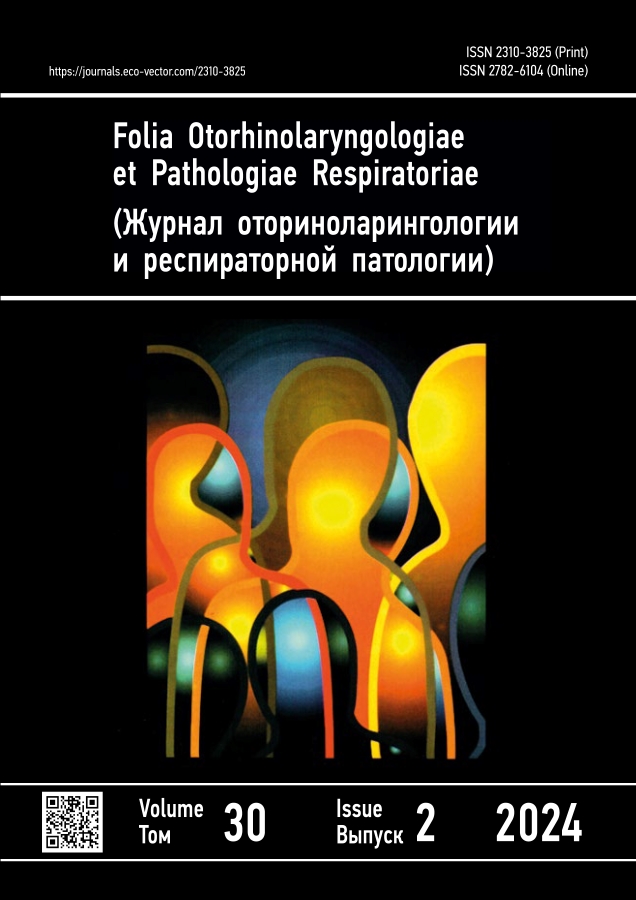Development of a graphical interface for medical data standardization for individuals with hearing disorders
- Authors: Gavrilov A.V.1, Kaplun D.I.1, Garbaruk E.S.2, Boboshko M.Y.2
-
Affiliations:
- Saint Petersburg Electrotechnical University “LETI”
- Academician I.P. Pavlov First St. Petersburg State Medical University
- Issue: Vol 30, No 2 (2024)
- Pages: 157-164
- Section: Original study
- Submitted: 01.09.2024
- URL: https://journals.eco-vector.com/2310-3825/article/view/635571
- DOI: https://doi.org/10.33848/fopr635571
- ID: 635571
Cite item
Abstract
BACKGROUND: One of the key tasks in healthcare practice is to collect and process patient data, especially in individuals with hearing impairments, because audiological examination includes a wide range of tests to determine severity and type of hearing loss and damage to the auditory system, to diagnose central auditory processing disorders, and to monitor auditory and speech rehabilitation. Collecting and processing data from such individuals is a complex task that requires precision and a high level of automation, as traditional manual data entry methods may have problems such as high error rates, time inefficiencies, and difficulty standardizing data.
AIM: The aim of the study was to develop a computer program for standardized and automated collection of personal and medical data of individuals with impaired hearing at the stages of diagnosis and auditory and speech rehabilitation.
MATERIALS AND METHODS: A total of 515 individuals with impaired hearing were evaluated? of whom 340 used hearing aids. In this study, a Graphical User Interface (GUI) was developed to standardize personal and medical data for patients with peripheral and central auditory system disorders at the stages of diagnosis and auditory and speech rehabilitation.
RESULTS: The program, developed in Python using the Kivy library, ensures cross-platform compatibility and flexibility. This software is designed to increase the speed and convenience of medical data collection, reducing and minimize errors and typos when entering test results through a simple, user-friendly interface.
CONCLUSIONS: The proposed GUI application improves the accuracy and reliability of the collected data, which is critical for the diagnosis and rehabilitation of patients.
Full Text
About the authors
Andrei V. Gavrilov
Saint Petersburg Electrotechnical University “LETI”
Author for correspondence.
Email: gamer_gav04@mail.ru
ORCID iD: 0009-0000-4321-3952
postgraduate student
Russian Federation, 5 Professora Popova St., Saint Petersburg, 197022Dmitry I. Kaplun
Saint Petersburg Electrotechnical University “LETI”
Email: dikaplun@etu.ru
ORCID iD: 0000-0003-2765-4509
Cand. Sci. (Technical)
Russian Federation, 5 Professora Popova St., Saint Petersburg, 197022Ekaterina S. Garbaruk
Academician I.P. Pavlov First St. Petersburg State Medical University
Email: kgarbaruk@mail.ru
ORCID iD: 0000-0002-9535-6063
SPIN-code: 5830-6560
Cand. Sci. (Biological)
Russian Federation, Saint PetersburgMaria Yu. Boboshko
Academician I.P. Pavlov First St. Petersburg State Medical University
Email: boboshkom@gmail.com
ORCID iD: 0000-0003-2453-523X
SPIN-code: 4409-0257
MD, Dr. Sci. (Medicine)
Russian Federation, Saint PetersburgReferences
- Ge J, Yan Y, Zhu Y, et al. Development and validation of the screening tool for age-related hearing loss in the community based on the information platform. Eur Arch Otorhinolaryngol. 2024;281(6):2893–2903. doi: 10.1007/s00405-023-08389-9
- Smith BD, Grush LD, Reavis KM, et al. Military service and hearing health: The NOISE Study. July/August Audiology Today issue. 2021;33(4):12.
- Edin J, Borgholt L, Junge A, et al. Automated Medical Coding on MIMIC-III and MIMIC-IV: a critical review and replicability study. In: Proceedings of the 46th International ACM SIGIR Conference on Research and Development in Information Retrieval. Association for Computing Machinery; 2023. P. 2572–2582. doi: 10.1145/3539618.3591918
- Mueller C, Herrmann P, Cichos S, et al. Automated electronic health record to electronic data capture transfer in clinical studies in the German Health Care System: Feasibility study and gap analysis. J Med Internet Res. 2023;25:e47958. doi: 10.2196/47958
- Stoumpos AI, Kitsios F, Talias MA. Digital transformation in healthcare: technology acceptance and its applications. Int J Environ Res Public Health. 2023;20(4):3407. doi: 10.3390/ijerph20043407
- Chopra H, Annu, Shin DK, et al. Revolutionizing clinical trials: the role of AI in accelerating medical breakthroughs. Int J Surg. 2023;109(12):4211–4220. doi: 10.1097/JS9.0000000000000705
- Magrabi F, Lyell D, Coiera E. Automation in Contemporary Clinical Information Systems: a survey of AI in healthcare settings. Yearb Med Inform. 2023;(1):115–126. doi: 10.1055/s-0043-1768733
- Tavartkiladze GA. Clinical audiology: national guidelines. Vol. 2. Diagnosis of hearing disorders. Moscow: GEOTAR-Media; 2024. 416 p. (In Russ.). doi: 10.33029/9704-8237-7-CLA-2024-1-416
- Boboshko MYu, Savenko IV, Garbaruk ES, et al. Practical audiology. Saint Petersburg: Dialog; 2021. 420 p. (In Russ.) EDN: CAQYGR
- Golovanova L, Artyushkin S, Ogorodnikova E, Boboshko M. Modern ways of auditory rehabilitation of elderly people. Folia otorhinolaryngologiae et pathologiae respiratoriae. 2020;26(3):11–22. EDN: HNZQXW doi: 10.33848/foliorl23103825-2020-26-3-11-22
- Warzybok A, Zhilinskaya E, Goykhburg M, et al. Clinical validation of the Russian matrix test – effect of hearing loss, age, and noise level. Int J Audiol. 2020;59(12):930–940. doi: 10.1080/14992027.2020.1806368
Supplementary files
















